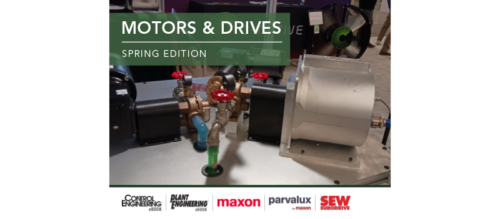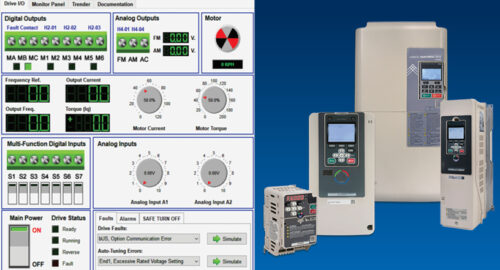Building energy efficiency into fan systems
Key concepts Taking a systems approach to fan systems can save significant amounts of energy.
Key concepts
Taking a systems approach to fan systems can save significant amounts of energy.
Energy savings are realized by improving system design and with proper equipment selection, maintenance, and operation.
Fan system decisions based on lowest initial cost instead of life-cycle cost can be unwise.
Industrial fan systems annually consume 78.7 billion kWh of electricity. The potential energy savings in these motor-driven systems using mature, proven, cost-effective technologies range between 11—18% of the current use.
Energy savings in industrial fan systems are realized in three ways:
-
By improving system design and controls
-
-
With proper equipment selection (size, special requirements, etc.)
-
-
Through proper maintenance and operation.
-
Systems approach to design efficiency
The U.S. Department of Energy’s Motor System BestPractices Program works with industry, including technical and trade associations, to undertake strategic actions for increasing the energy-efficiency of motor-driven systems. As an example, the BestPractices program and the Air Movement and Control Association, Intl., Inc. have been working cooperatively to increase awareness of energy efficiency improvement opportunities for industrial fan systems. The BestPractices program also encourages a move from component-focused to systems-focused decision-making.
This systems approach integrates the design, specification, and installation of fan systems in meeting process airflow requirements. It takes into account all parameters and efficiencies (Fig. 1) from the point at which power enters the motor drive system to where work on the fluid takes place.
When implementing a systems approach, current (or expected) operating conditions, along with present and future process needs, must first be determined. Once these points are finalized, a fan and motor can be sized appropriately. System effects should be considered before the selection of the fan and motor is finalized.
Many processes require variable airflow. The system may not operate under full design conditions at all times, leading to a load factor (ratio of required operating power to the design power capability) of less than 1. Engineers normally consider design operating conditions, and in most cases add a safety factor, when selecting the fan and motor. If a selection is based on design conditions only and a safety factor is included in excess of the design, the motor and the fan are typically oversized.
For example, an application requires a design airflow of 40,000 cfm of air and a total pressure of 2.5-in. w.g. Applying a safety factor of 15% raises the requirement to 46,000 cfm at 2.5-in. w.g. The performance curve for the selected fan is shown in Fig. 2. “A” is the point of selection. It also provides the brake horsepower required.
If the load factor on this application is 0.8, then the actual airflow requirement is 32,000 cfm. The operating point, then, is now at point B where a significant amount of extra pressure is developed. The result is substantial energy waste. If properly configured, a smaller motor and fan could be used to achieve the same result.
A duct system curve is a graphical representation of the pressure drop (delta P ) with respect to the airflow rate ( Q ) through the duct. As the airflow rate changes, the pressure drop also changes. Mathematically, the relationship is expressed as:
(delta) P } Q 2
The intersection of the duct system curve and performance curve of the fan determines the operating point. Therefore, it is important to determine the duct system curve properly by considering all system effect factors (SEF) that account for the overall resistance of the duct system. More information about determining the SEF of a system is available in AMCA Publication 201-90. (Information on this literature and other resources are provided in the More info section at the end of this article.)
Equipment selection and analysis tools
After taking into account the required pressure and all system effect factors with the associated duct system, the fan and motor system can be sized for the necessary airflow rate. In some instances, fans and motors are oversized to accommodate overlooked contingencies. Dampers and inlet guide vanes are then used to control the airflow during normal operation, which wastes energy. Sizing the fan, motor, and controls properly when the system is designed avoids these losses and results in significant energy savings.
Fans. Selecting the right fan and controllers for a system is an involved and iterative task. Manufacturers’ catalogs are the best places to begin research. The type of fan, design airflow rate, and pressure requirement should be known. Other essential details may include the material of construction, type of bearings, power supply, and type of controller. Nomographs and slide rules have been used for a long time to calculate this information, but are being replaced by computer software tools.
Most manufacturers and their suppliers provide software programs that serve as catalogs from which users can select fans based on their requirements. Performance curves are typically included in the software, providing a view of fan performance over the entire operating range. The programs also sort applicable fans based on efficiency, cost, and size; and display the results on screen. Although the software is easy to use, the comparative information is usually limited to a specific manufacturer.
Motors. The Energy Policy Act (EPAct) of 1992 imposed new, minimum efficiency standards effective October 1997 for general-purpose, induction motors of NEMA designs A and B. These motors are typically 3—8 percentage points higher in efficiency than standard motors. A higher-efficiency, “premium” class of motors is also available. They contribute to the overall energy savings of the system.
Motors 50 hp or less are normally included with the fan and supplied as a package by the manufacturer. Different motors can be specified by the user, depending on the requirement. A selection of premiummotors can be a sound option in many cases. A software package, MotorMaster+ 3.0 is available from the BestPractices Program to assist with motor selection. The software may be obtained at no cost through the Office of Industrial Technologies (OIT) Clearinghouse or can be downloaded from the BestPractices web site. (See More info section for details.)
The software includes a built-in database of more than 27,000 U.S. motors and has the capability to compare different motors and compute relative costs (including initial, annual energy, and life cycle costs) and savings for the motors being considered.
Drives. Drives couple the motor to the fan, and can be fixed or adjustable speed. Most applications use a fixed speed drive. The most common type is a belt drive. Belts allow the flexibility of positioning the motor relative to the load. The fan speed can be changed by using pulleys of different sizes. Types of belts include V, cogged V, synchronous, and flat. V-belts are the most common. (AMCA Publication 203 provides a chart to estimate belt-drive efficiency loss. See More info section for details . ) Cogged V-belts deliver 1—3% better efficiency rates than standard belts, but the initial cost could be 20—30% more. Synchronous belts have teeth that engage with those of the sprocket pulleys, thereby eliminating slippage. Ideally, this situation would lead to higher system efficiency, but because of speed mismatches resulting from the limited number of cog sizes, this result is not always achieved.
An adjustable speed drive (ASD) may provide large energy saving opportunities in situations with varying loads. ASDs are broadly classified into two categories: mechanical and hydraulic drives, and electrical and magnetic drives. Mechanical drives consist of gears and/or belts and pulleys. They are low cost but provide a limited speed range and turndown capability. Hydraulic drives provide wider speed control and higher torques, are simple to control, and are normally applied to smaller motors (less than 30 hp). They require more maintenance because they have additional piping, fluids, and moving parts and do not provide any energy savings.
Types of electrical and magnetic drives include eddy current coupling, permanent magnet eddy current coupling, rotating dc, solid state dc, and solid state ac. Eddy current couplings are low cost and provide simple control. However, they generate a lot of heat. Permanent magnet eddy current couplings provide good turndown (75% and more) and allow for vibration isolation between the load and the motor. Heat removal may be a concern for large sizes. Rotating dc drives allow for a wide speed range and regeneration, but are limited by high maintenance costs and large sizes. Solid state dc drives offer a wide range of speed controls, good efficiency, and low costs but can be applied only to dc motors. These motors are expensive and large and have high maintenance requirements.
The solid state ac drive, also known as a variable frequency drive (VFD), iscurrently one of the most compact and energy efficient options that still allows precise control. Although VFDs are easy to add to a system, installation must be done according to motor specifications. Not all VFDs are compatible with all types of motors. Although VFDs have some associated losses, units that are properly installed and operated provide significant energy savings and quick paybacks on fan systems with varying airflow requirements (specifically for airflow reductions greater than 50% of design).
For example, a fan provides 25,000 cfm of air running at 1750 rpm and consuming 30 hp. Process conditions change and the load decreases by 30%, making the new airflow requirement 17,500 cfm. Two options are now available.
Option 1 (Fig. 3). Use the existing fan and motor assembly to control airflow at 17,500 cfm and a damper to increase overall system pressure drop artificially. The fan performance curve remains the same, but the system curve changes. No significant energy is saved.
Option 2 (Fig. 4). Use a VFD and control airflow at 17,500 cfm. The fan performance curve drops below the original curve, while the system curve remains the same. Fan affinity laws state that power is proportional to the cube of the fan speed. In this example, therefore, a 30% drop in fan speed reduces power use to approximately 35% of its original value.
Many drive manufacturers now have software to evaluate the energy savings potential of VFDs. The Electric Power Research Institute also offers ASDMaster software for evaluating VFD applications. (See More info section for details.) For some applications, use of variable-pitch axial fans may prove to be more cost effective than the use of VFDs. Engineers need to consider this option when evaluating all the options.
Economics, operation, and maintenance
Often, the initial equipment cost is the primary factor in selecting a fan system. In a highly competitive and cost-sensitive market, decisions based on lowest initial cost instead of life-cycle cost (LCC) can be unwise. With motors, for example, 90—95% of the LCC is the expense of motor operation (including energy expenditures) and maintenance. A decision based on the initial expense would not lead to a cost-effective solution. LCC requires more detailed analysis, but is a valuable technique. It allows decision-makers to foresee the future in terms of life expectancy, as well as overall expenses related to the operation and maintenance of a particular system.
An important element of a systems approach is continued monitoring following installation and startup. Fans and associated components must be properly maintained according to manufacturer’s guidelines so that they operate through their expected lifetime.
Filters, heat exchanger coils, and ducts are prone to dirt accumulation and clogging over time. Dirt build-up increases fouling on heat exchanger coils, reduces the effective flow area, and increases pressure drop. The delivered airflow rate is reduced and maintenance is expected to clean the clogged and fouled areas. Depending on what area is clogged and fouled, the cleaning operation could be as simple as changing a filter cartridge or as difficult as removing a tube bundle from a heat exchanger.
Systems that involve heat exchangers may encounter a secondary effect that is often overlooked. This effect is a reduction in the heat transfer coefficient caused by a drop in fluid velocity and is associated with clogged filters, fouled coils, and other components. The overall heat transfer coefficient is normally controlled by the airside, but any drop in this coefficient penalizes the heat transfer and the process. A clean coil has a lower pressure drop and requires a smaller heat exchange area.
Cleaning frequency depends on the specific application, variability in airflow that can be tolerated by the process, and required hygiene levels. A scheduled maintenance procedure should be established to keep systems clean. Monitoring pressure drops across filters, coils, and other components is an effective way to determine if system components are free of dirt build-up.
With belt drives , proper belt tension is critical to fan performance. Too much tension stresses belts, bearings, and shafts. Too little tension causes slip, high losses, and early failure. Belts stretch during operation and need periodic retensioning to prevent slippage. They also rely on the friction created between themselves and the pulley to transmit the torque. Liquids, dust, wear, and other factors change this friction and limit the torque transfer capability of belts.
Other side effects of a worn belt include vibration, nonuniform loading on the fan shaft leading to bearing failure, and high noise. Belts directly affect system efficiency. They must be periodically checked for proper tension and should be a regular part of any maintenance program.
The impeller, its blades, and housing are typically constructed with materials compatible with the working fluid. However, blade wear may still occur. When the impeller comes in direct contact with the working fluid, dust and other particles hit the blades. Over time, the edges erode, changing the blade profile. This development may change the performance curve of the fan and leads to a new operating point.
Impeller blades should be kept free of any accumulation. Dust and particle accumulation or changes in blade shape may cause impeller imbalance. This condition often leads to nonuniform bearing and shaft loads.
In vane-axial fans, the impeller housing must also be kept free of any particulate accumulation. Buildup of particulate reduces the clearance between the housing and blade tip, leading to a grazing of the blade tip and housing. This condition results in blade tip wear and also changes the performance curve of the fan.
Industrial fan systems consume approximately 13.7% of overall U.S. industrial electricity. Market assessments show that the potential for significant energy savings exists for these systems. The U.S. Department of Energy’s BestPractices Program encourages users to adopt a systems approach to fan systems, following the guidelines discussed to achieve these predicted savings, and then to maintain and operate systems properly to retain these energy benefits.
—Edited by Jeanine Katzel, Senior Editor, 630-320-7142, jkatzel@cahners.com * The authors wish to thank A.T. McKane, Lawrence Berkeley National Laboratory, and C. Romanowski, American Council for an Energy Efficient Economy, for their assistance with this article.
More info Fans and Systems, AMCA Publication 201-90, and Field Performance Measurement of Fan Systems, AMCA Publication 203-90, are available from the Air Movement and Control Association Intl., Inc., 30 W. University Dr., Arlington Heights, IL 60004-1893; 847-394-0150; fax: 847-253-0088; www.amca.org .
MotorMaster+ 3.0 Windows-based software was developed for the U.S. Department of Energy’s BestPractices Program and is available at no cost from the web site: www.motor.doe.gov
ASDMaster, an adjustable speed drive evaluation and applications software package, is available from the Electric Power Research Institute, 3412 Hillview Ave., Palo Alto, CA 94304; 800-313-3774; www.epri.com .
Technical questions about this article may be directed to author Riyaz Papar by phone at 202-646-7950, or by e-mail at mailto:RAPapar@ lbl.gov.
-
-
Do you have experience and expertise with the topics mentioned in this content? You should consider contributing to our CFE Media editorial team and getting the recognition you and your company deserve. Click here to start this process.





